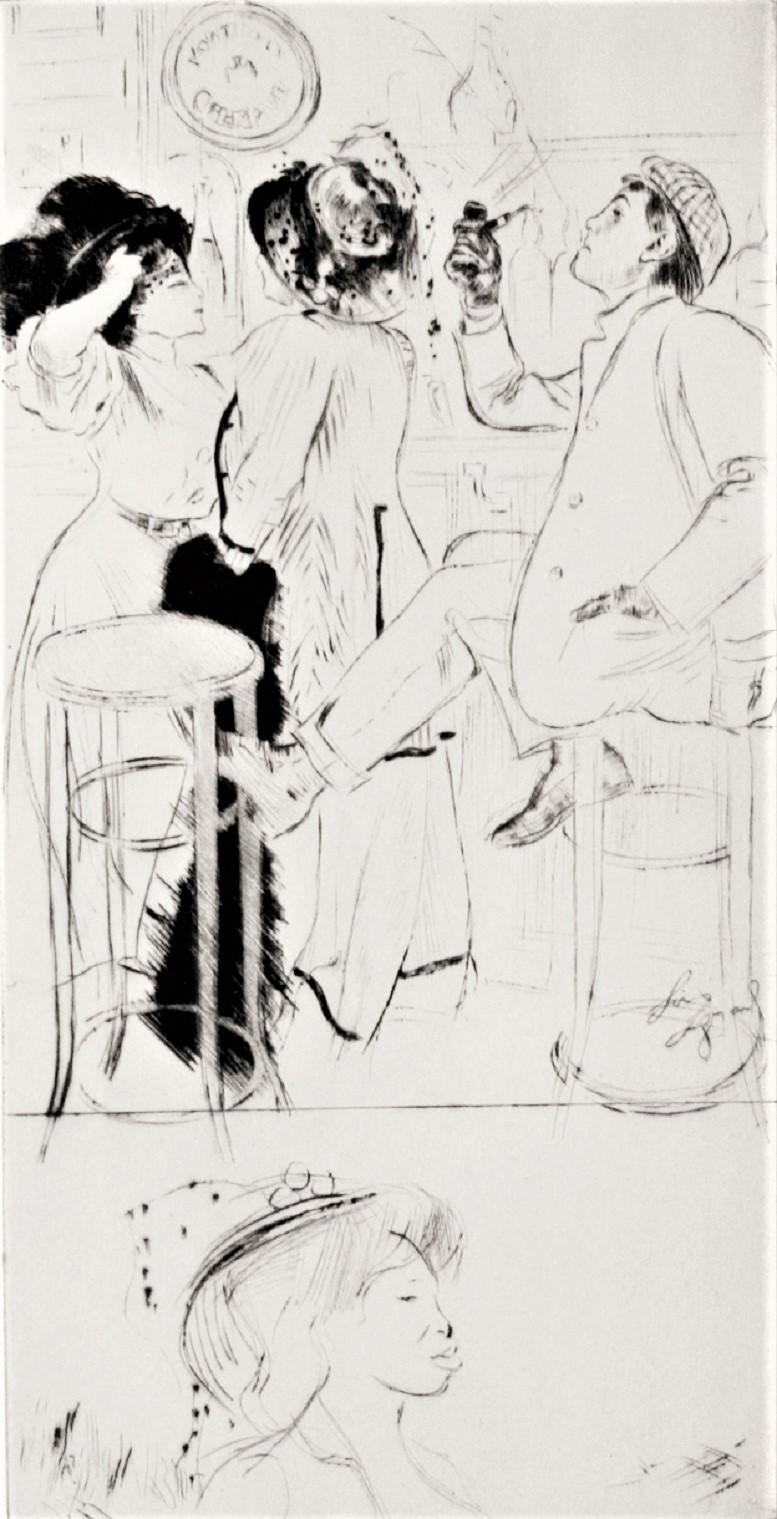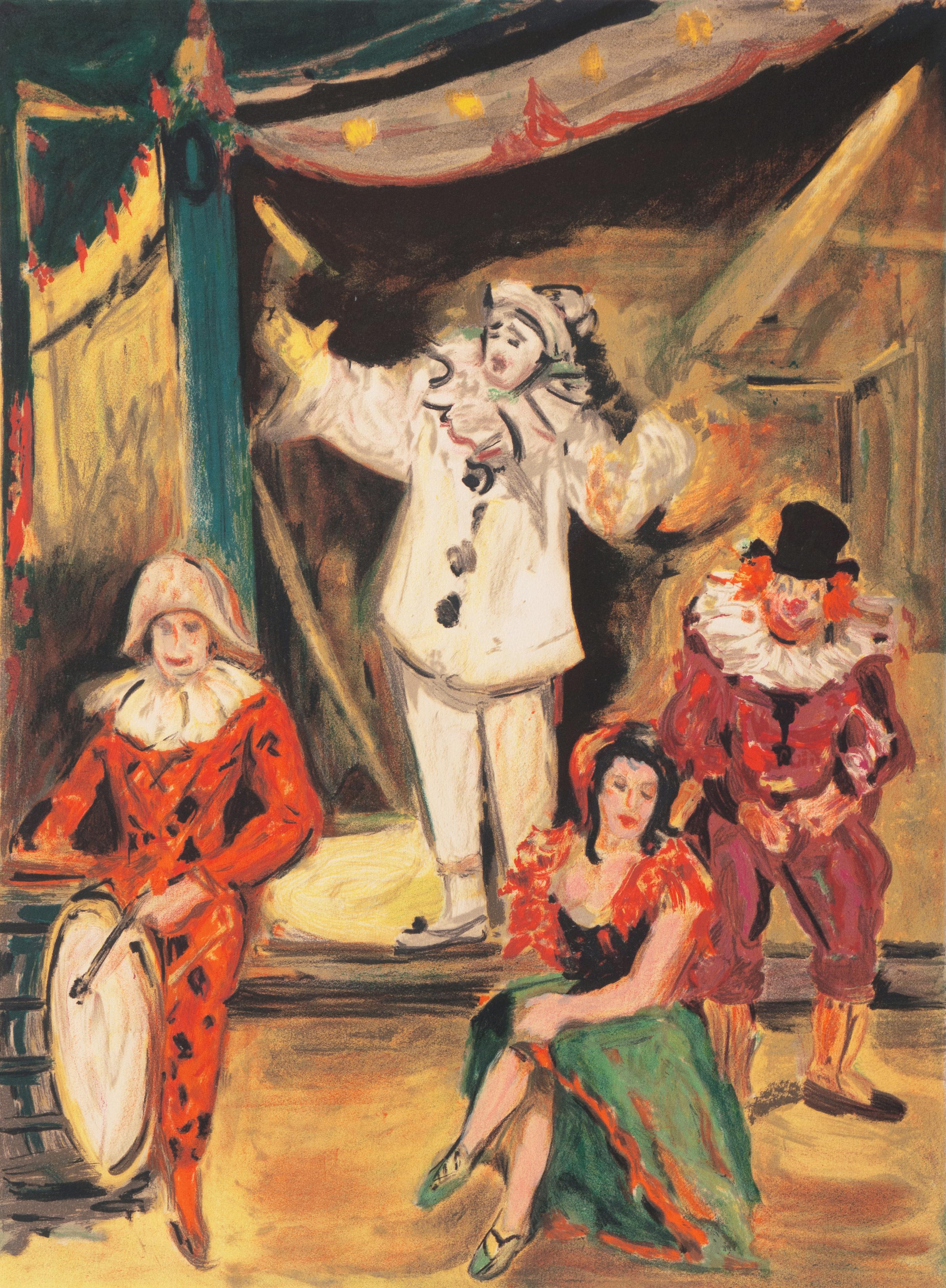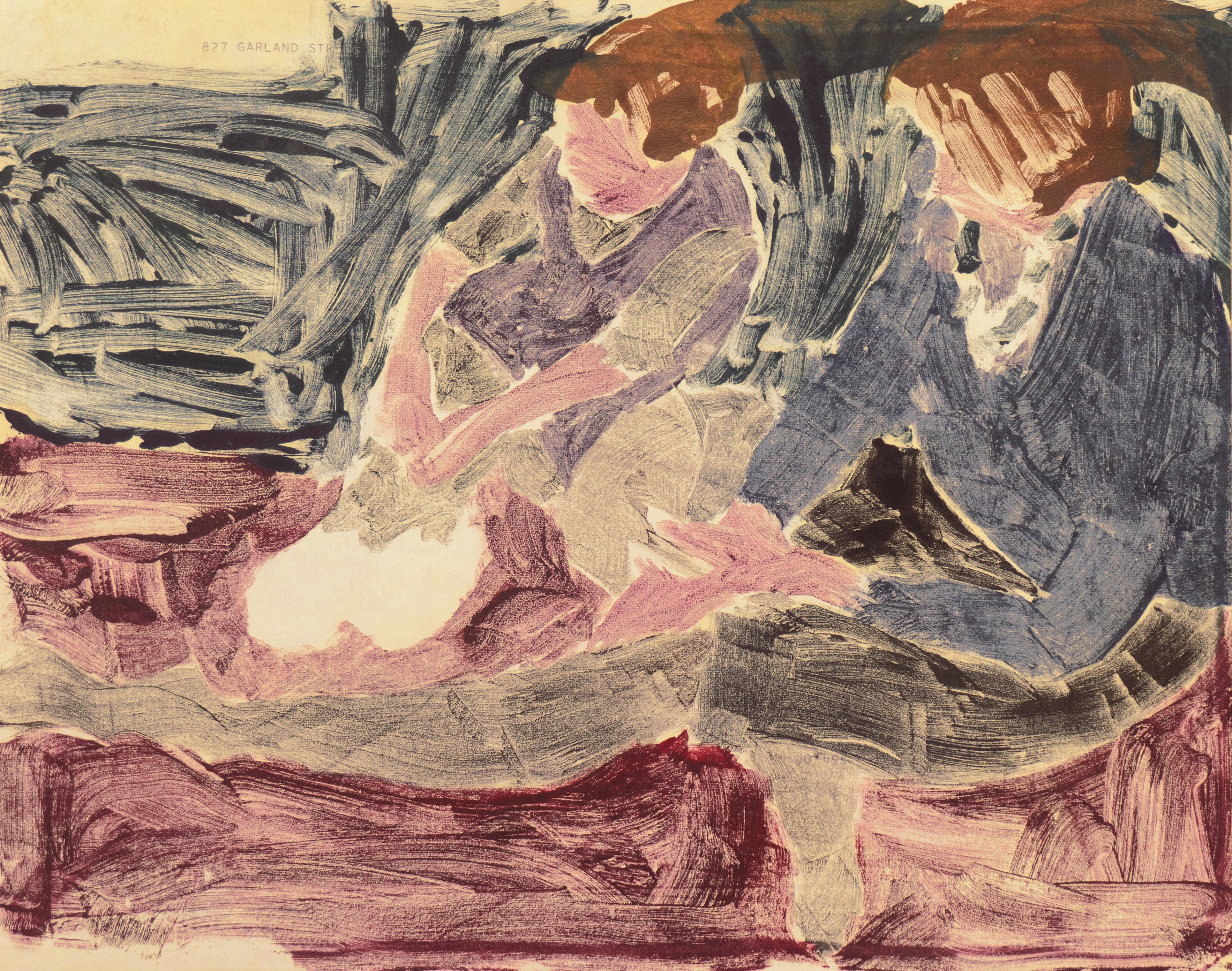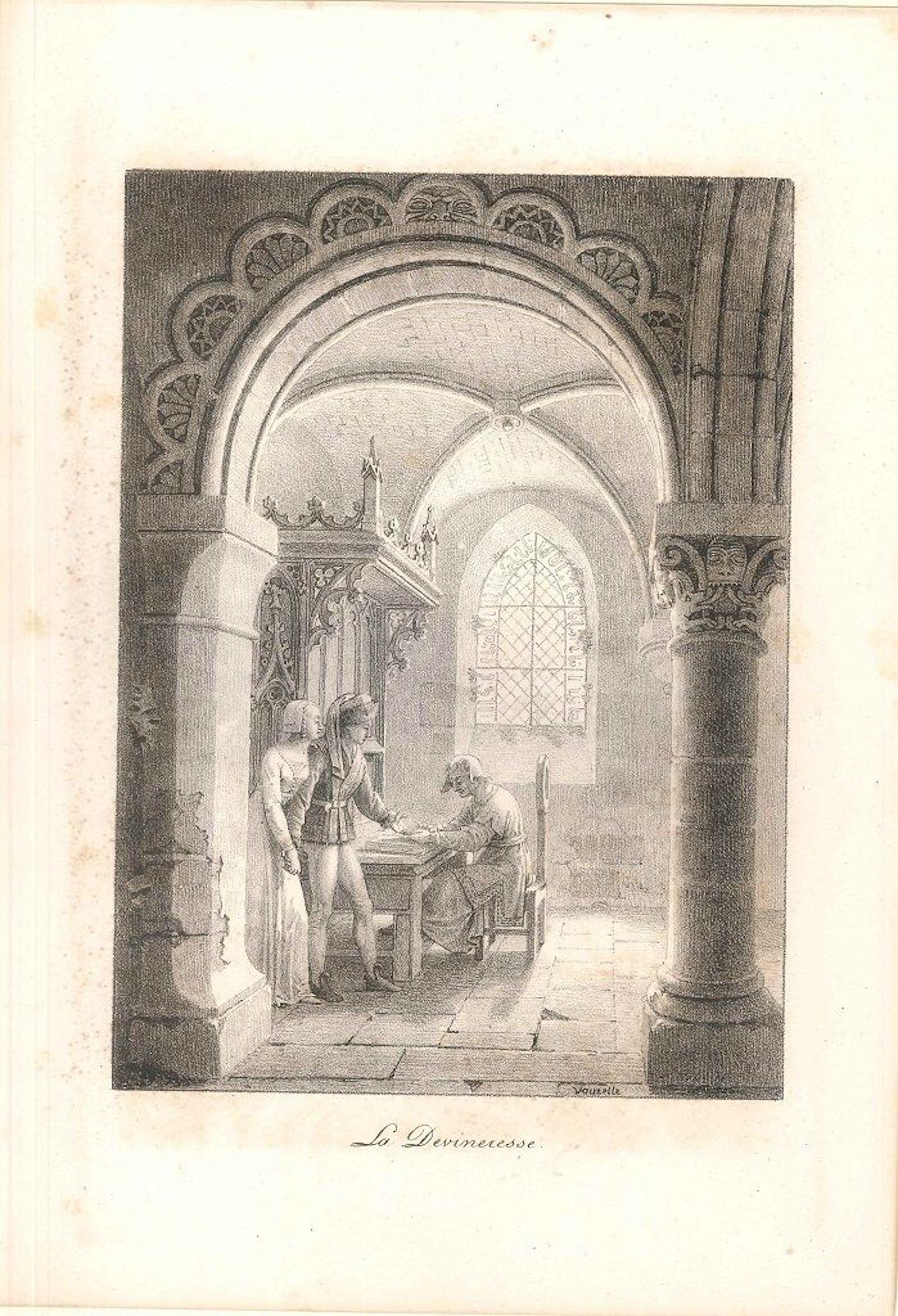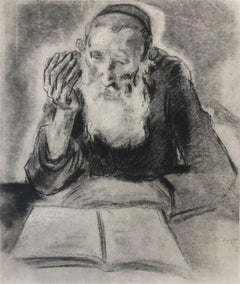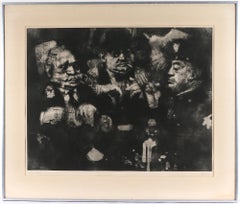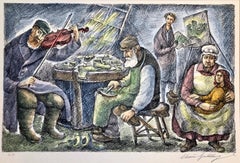
Judaica Lithograph Shtetl Interior Scene Etching Jewish Fiddler and Cobbler
View Similar Items
Want more images or videos?
Request additional images or videos from the seller
1 of 12
Chaïm GoldbergJudaica Lithograph Shtetl Interior Scene Etching Jewish Fiddler and Cobblerc.1960s
c.1960s
About the Item
- Creator:Chaïm Goldberg (1917-2004, Polish)
- Creation Year:c.1960s
- Dimensions:Height: 17.5 in (44.45 cm)Width: 23.5 in (59.69 cm)
- Medium:
- Movement & Style:
- Period:
- Condition:matted but not framed.
- Gallery Location:Surfside, FL
- Reference Number:1stDibs: LU3823574941
About the Seller
4.9
Platinum Seller
These expertly vetted sellers are 1stDibs' most experienced sellers and are rated highest by our customers.
Established in 1995
1stDibs seller since 2014
1,552 sales on 1stDibs
Typical response time: 1 hour
More From This SellerView All
- Judaica Jewish Shtetl Etching Yeshiva Talmudic Study Vintage Chassidic Art PrintBy Paul JeffayLocated in Surfside, FL"Qui a raison?" Chassidic boy, Yeshiva student with open book. Judaica, Jewish scenes from a ghetto. Saul Yaffie, a.k.a. Paul Jeffay, (1898–1957) was a Scottish Jewish artist. Known for his charming French street scenes as well as his judaica work. This is signed in the plate and dated 1931 in the print. This is done in a style similar to the works of the early Bezalel School artists Hermann Struck and Jakob Steinhardt. This lithograph, by artist Paul Jeffay depicts a Judaic Shtetl interior scene with great charm and sensitivity. Saul Yaffie was born in Blythswood, Glasgow on 29 April 1898. His mother was Kate Yaffie (née Karkonoski), and his father, Bernard Yaffie, was a master tailor. Like many Russian Jews, Kate and Bernard Yaffie fled persecution in Russia during a wave of anti-Jewish pogroms triggered by the assassination of Tsar Alexander II in 1881. Saul's father was naturalised as a British citizen by the time that Saul himself was three; a Bernard Yaffie is recorded as living at Abbotsford Place in the old Gorbals, where the young Saul spent the early years of his childhood. The Yaffies were not unique in their situation: the Gorbals was the centre of Scotland's Jewish community and home to a large proportion of Glasgow's immigrants throughout the early 20th century. Over time, there was a movement to some of the more affluent communities in Glasgow, such as Pollokshields and Garnethill, as many Jewish families gradually improved their social and economic situation. Like these, the Yaffies also experienced a time of good fortune, moving to a more agreeable address on Sinclair Drive, Cathcart as Bernard's tailoring business prospered. Saul attended day classes in drawing and painting, modelling, and life drawing at The Glasgow School of Art from 1912 to 1919. During the First World War, he was required to interrupt his studies to serve in the King's Own Scottish Borderers in 1916/17. Although subject to military conscription, Yaffie reached the rank of corporal during his service. Prior to his conscription Yaffie engaged in munitions work, something that was recorded in the GSA's student registers. The post-war economic depression that affected the country during the 1920s, also affected the Yaffie family directly: Bernard Yaffie's business suffered greatly, and the family eventually emigrated to Canada. Saul did not emigrate with his family, choosing instead to stay in Europe, and relocate to jazz age Paris where he continued his artistic practice. Now married, Saul sought to escape persecution in Europe by returning to the UK before the Second World War with his wife, Estusia. The two settled in Manchester, but returned to France after the war. In his memoires ‘Bronze in My Blood’, German-born sculptor Benno Schotz describes a Saul ‘Yaffe’, one of only three other Jewish students who attended The Glasgow School of Art at the time. (Schotz himself was exempt from joining the forces because he was ‘not yet a British subject’, and was engaged in war work in the drawing office of John Brown’s shipyards). On the outbreak of the war, Schotz writes, Yaffie won a poster competition to be displayed in Glasgow tramcars at the beginning of the 1914-18 war – his winning design depicted a woman with a child in her arms, fleeing from a fire behind her. While on leave from service, the young Saul told Schotz he had briefly been stationed in the same unit as Jewish American sculptor Jacob Epstein. This was most likely the 38th Battalion of the Royal Fusiliers, also known as ‘the Jewish Legion’, one of five Jewish battalions raised during WW1. ‘He told me how incongruous it was’, remembers Schotz, ‘to See Epstein scrubbing the floor of their hut, with a large diamond ring on his finger’. His work is included in the collection of the Ben Uri Museum in London along with Lucian Freud, David Bomberg, Mark Gertler, Josef Herman, Jankel Adler, Feliks Topolski...Category
20th Century Expressionist Interior Prints
MaterialsEtching
- Judaica Jewish Shtetl Etching Hasidic Rabbi at Study Vintage Chassidic PrintBy Paul JeffayLocated in Surfside, FLOlder Chassidic rabbi learning with open book, Judaica, Jewish scenes from a ghetto. Saul Yaffie, a.k.a. Paul Jeffay, (1898–1957) was a Scottish Jewish artist. Known for his charming French street scenes as well as his judaica work. This is signed in the plate and dated 1931 in the print. This is done in a style similar to the works of the early Bezalel School artists Hermann Struck and Jakob Steinhardt. This lithograph, by artist Paul Jeffay depicts a Judaic Shtetl interior scene with great charm and sensitivity. Saul Yaffie was born in Blythswood, Glasgow on 29 April 1898. His mother was Kate Yaffie (née Karkonoski), and his father, Bernard Yaffie, was a master tailor. Like many Russian Jews, Kate and Bernard Yaffie fled persecution in Russia during a wave of anti-Jewish pogroms triggered by the assassination of Tsar Alexander II in 1881. Saul's father was naturalised as a British citizen by the time that Saul himself was three; a Bernard Yaffie is recorded as living at Abbotsford Place in the old Gorbals, where the young Saul spent the early years of his childhood. The Yaffies were not unique in their situation: the Gorbals was the centre of Scotland's Jewish community and home to a large proportion of Glasgow's immigrants throughout the early 20th century. Over time, there was a movement to some of the more affluent communities in Glasgow, such as Pollokshields and Garnethill, as many Jewish families gradually improved their social and economic situation. Like these, the Yaffies also experienced a time of good fortune, moving to a more agreeable address on Sinclair Drive, Cathcart as Bernard's tailoring business prospered. Saul attended day classes in drawing and painting, modelling, and life drawing at The Glasgow School of Art from 1912 to 1919. During the First World War, he was required to interrupt his studies to serve in the King's Own Scottish Borderers in 1916/17. Although subject to military conscription, Yaffie reached the rank of corporal during his service. Prior to his conscription Yaffie engaged in munitions work, something that was recorded in the GSA's student registers. The post-war economic depression that affected the country during the 1920s, also affected the Yaffie family directly: Bernard Yaffie's business suffered greatly, and the family eventually emigrated to Canada. Saul did not emigrate with his family, choosing instead to stay in Europe, and relocate to jazz age Paris where he continued his artistic practice. Now married, Saul sought to escape persecution in Europe by returning to the UK before the Second World War with his wife, Estusia. The two settled in Manchester, but returned to France after the war. In his memoires ‘Bronze in My Blood’, German-born sculptor Benno Schotz describes a Saul ‘Yaffe’, one of only three other Jewish students who attended The Glasgow School of Art at the time. (Schotz himself was exempt from joining the forces because he was ‘not yet a British subject’, and was engaged in war work in the drawing office of John Brown’s shipyards). On the outbreak of the war, Schotz writes, Yaffie won a poster competition to be displayed in Glasgow tramcars at the beginning of the 1914-18 war – his winning design depicted a woman with a child in her arms, fleeing from a fire behind her. While on leave from service, the young Saul told Schotz he had briefly been stationed in the same unit as Jewish American sculptor Jacob Epstein. This was most likely the 38th Battalion of the Royal Fusiliers, also known as ‘the Jewish Legion’, one of five Jewish battalions raised during WW1. ‘He told me how incongruous it was’, remembers Schotz, ‘to See Epstein scrubbing the floor of their hut, with a large diamond ring on his finger’. His work is included in the collection of the Ben Uri Museum in London along with Lucian Freud, David Bomberg, Mark Gertler, Josef Herman, Jankel Adler, Feliks Topolski...Category
20th Century Expressionist Figurative Prints
MaterialsPaper, Etching
- American Modernist "Feast of Pure Reason" Aquatint Mezzotint Etching WPA ArtistBy Jack LevineLocated in Surfside, FLJack Levine, American, 1915–2010 The Feast of Pure Reason, 1970 Etching, mezzotint and aquatint on copper in black ink. 20 w. 25 in., sight overall: 27 x 31.75 in., matted. Depict...Category
1970s Expressionist Figurative Prints
MaterialsMezzotint, Etching, Aquatint
- 1936 Lithograph Interregnum, Cigar, Kid w Toy Gun, Small Edition Weimar GermanyBy George GroszLocated in Surfside, FLHand lithography on BFK Rives French hand moulded paper Style: German New Objectivity (Neue Sachlichkeit) According to the frontis these were produced by Hand Lithography. According...Category
1930s Modern Interior Prints
MaterialsLithograph
- 1936 Lithograph Interregnum Portfolio Butcher Shop Small Edition Weimar GermanyBy George GroszLocated in Surfside, FLHand lithography on BFK Rives French hand moulded paper Style: German New Objectivity (Neue Sachlichkeit) According to the frontis these were produced by Hand Lithography. According...Category
1930s Modern Interior Prints
MaterialsLithograph
- 1936 Lithograph Interregnum portfolio Artist Studio small edition Weimar GermanyBy George GroszLocated in Surfside, FLHand lithography on BFK Rives French hand moulded paper Style: German New Objectivity (Neue Sachlichkeit) According to the frontis these were produced by Hand Lithography. According...Category
1930s Modern Interior Prints
MaterialsLithograph
You May Also Like
- SportsmenBy Louis LegrandLocated in Storrs, CTSportsmen. 1908. Etching and drypoint. Exsteens 271.i/ii. 11 1/4 x 5 3/4 (sheet 17 3/8 x 12 1/4). Series: Les Bars. From the first state edition of 30 proofs with the remarque sketch...Category
Early 1900s Post-Impressionist Figurative Prints
MaterialsDrypoint, Etching
$875 Sale Price50% Off - Tavern - Etching by Marcel Gromaire - 1952By Marcel GromaireLocated in Roma, ITTavern is a black and white etching on paper, realized in 1952 by Marcel Gromaire (1892-1971). Monogrammed on plate on the lower left corner. Good conditions except for some foxing...Category
1950s Post-Impressionist Figurative Prints
MaterialsEtching
$310 Sale Price20% Off - "La Conversation" Large original lithographBy Jean-Pierre CassigneulLocated in San Francisco, CAThis art work titled "La Conversation" 1991 is an original color lithograph on wove paper by French artist, Jean Pierre Cassigneul, born 1935. It is h...Category
Late 20th Century Post-Impressionist Figurative Prints
MaterialsLithograph
- 'Pierrot's Lament', Post-Impressionist, Paris Salon, Centre Pompidou, NY MoMABy Arbit BlatasLocated in Santa Cruz, CASigned lower right, 'Arbit Blatas' (Lithuanian, 1908-1999) and with number and limitation, '123/195', lower left. Lithuanian born, Arbit Blatas first studied in Paris at the Academie de la Grande Chaumiere and, subsequently, at the Academie Julian. He was a member of the Salon d'Automne where he also exhibited. Other exhibition venues included the Carnegie Institute, the Pennsylvania Academy, the Santa Barbara Museum and the Rhode Island School of Design. An artist of great range, his vivid colors and joie de vivre extend through his entire canon of paintings: landscapes, portraits and still-lives. The distinguished French art critic, Jean Bouret, summed the artist up in this way: "He is color, his palette is color, exuberant and sensual, as is the man." On the other end of Blatas' artistic spectrum, the noted Italian art historian Enzo di Martini wrote of the Monument of the Holocaust: "In complete contrast to his paintings, these bronzes are hammered and chiseled in anger and tragedy." In 1929 he began to exhibit regularly at the Salon D'Automne and the Salon des Tuileries in Paris. At the age of twenty-one, he became the youngest member of the School of Paris and a friend and colleague to many of the great figures in the Parisian art world such as Vlaminck, Utrillo, Soutine, Picasso, Derain and Matisse. Blatas eventually painted or sculpted them all and his forty-nine portraits in oil and bronze are considered a unique document of that period in Paris. The artist exhibited regularly in the principal galleries of New York, Paris and London. His works are also included in some of the most valued private international art collections. Sheet dimensions: 25.5 x 19 inches. Partial List of Exhibitions: NEW YORK - Pierre Matisse Gallery; Associated American Artists; French Art Gallery; Bignou Gallery; Fine Arts Associates; Hirschl & Adler Galleries, Inc.; Eastlake Gallery; Beacon Hill Fine Arts Gallery PARIS - Galerie Zborowski; Salon D'Automne; Salon des Tuileries; Galerie Mouradian-Van Leer; Galerie Mouradian-Vallotton; Salon Populiste; Galerie de l'Elysée; Galerie André Weil; Galerie Bernheim-Jeune; Galerie René Drouet LONDON - Wildenstein Gallery; Grosvenor Gallery; Archer Gallery; Fine Arts Society; Redfern Gallery VENICE - Gritti Palace; Chiesa di San Samuele; Teatro Goldoni; Galleria Graziussi; Chiesa San Stae TREVISO - Teatro Comunale LAUSANNE - Galerie Vallotton TORONTO - Goethe Institute MONTREAL - Gallery Moos SYDNEY - Holdsworth Gallery. Partial List of Collections: USA - Metropolitan Museum of Art, New York; Museum of Modern Art, New York; Whitney Museum of American Art, New York; Museum of the City of New York; National Portrait Gallery; the Smithsonian Institution; Carnegie Institute, Pittsburgh; Rochester Museum; Virginia Museum; Delgado Museum, New Orleans; Palm Springs Desert Museum; Wichita Art Museum FRANCE - Jeu de Paume, Paris; Le Centre Pompidou...Category
Mid-20th Century Post-Impressionist Interior Prints
MaterialsLithograph, Paper
$1,925 Sale Price30% Off - 'The White Clogs', Paris, Louvre, Salon d'Automne, Ac. Chaumière, LACMA, SFAABy Victor Di GesuLocated in Santa Cruz, CAPainted by Victor Di Gesu (American, 1914-1988) circa 1955 and stamped, verso, with Victor di Gesu estate stamp. A bold, expressionist monotype showing two young women seated side b...Category
1950s Post-Impressionist Figurative Prints
MaterialsPaper, Monotype
- The Attic RoomBy Louis IcartLocated in Fort Washington, PAMedium: Lithograph and Etching Signature: Pencil Signed and -197 Etched in Margin Image of a woman in an attic room.Category
1940s Figurative Prints
MaterialsLithograph, Etching
Recently Viewed
View AllMore Ways To Browse
Chagall I And The Village
Chaim Goldberg
Vintage Cobbler
Chagall Etching Watercolor
Diner Mug
James Carter On Sale
Michael Hasted On Sale
Jukka Vanttinen On Sale
David Roberts Aboo
David Hockney Rue De Seine
Louis Vuitton Drugs
Louis Vuitton Drug
Aboo Simbel
Doug Bloodworth On Sale
Masahiro Arai On Sale
Guy Charon On Sale
Vintage Cocktail Waitress
Alan Herman On Sale
